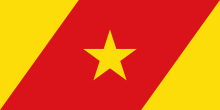Beyeda
Beyeda (Amharic: በየዳ ) is one of the woredas in the Amhara Region of Ethiopia. Located in the easternmost point of the Semien Gondar Zone, Beyeda is bordered on the south by the Wag Hemra Zone,
Beyeda በየዳ | |
|---|---|
Woreda | |
 Flag | |
| Zone | Semien Gondar |
| Region | Amhara Region |
| Area | |
| • Total | 973.05 km2 (375.70 sq mi) |
| Population (2012 est.) | |
| • Total | 105,482 |
on the west by Jan Amora, on the north by Tselemt, and on the east by the Tekezé River which separates it from the Tigray Region. The major town in Beyeda is Dil Yibza.
The highest peak in Beyeda is Mount Ras Dashen 4620 meter and the second is Mount Biuat 4437 meters, one of the ten highest mountains in Ethiopia; other notable peaks include Mount Meseraia and Mount Selki. All of these are members of the Semien Mountains, which cover most of this woreda; part of the Semien Mountains National Park is also located in northern Beyeda. Due to its inaccessibility and the lack of the most basic infrastructure, in 1999 the Regional government classified this woreda as one of its 47 drought prone and food insecure woredas.[2]
Demographics
Based on the 2007 national census conducted by the Central Statistical Agency of Ethiopia (CSA), this woreda has a total population of 97,492, an increase of 27.14% over the 1994 census, of whom 47,877 are men and 49,615 women; 3,292 or 3.38% are urban inhabitants. With an area of 973.05 square kilometers, Beyeda has a population density of 100.19, which is greater than the Zone average of 63.76 persons per square kilometer. A total of 21,742 households were counted in this woreda, resulting in an average of 4.48 persons to a household, and 21,257 housing units. The majority of the inhabitants practiced Ethiopian Orthodox Christianity, with 98.9% reporting that as their religion.[3]
The 1994 national census reported a total population for this woreda of 76,680 in 16,933 households, of whom 38,369 were men and 38,311 women; 1,001 or 1.31% of its population were urban dwellers at the time. The largest ethnic group reported in Beyeda was the Amhara (99.72%); all other ethnic groups made up 0.28% of the population. Amharic was spoken as a first language by 99.55%; the remaining 0.45% spoke all other primary languages reported. The majority of the inhabitants practiced Ethiopian Orthodox Christianity, with 99.64% reporting that as their religion.[4]
Notes
- Geohive: Ethiopia Archived 2012-08-05 at the Wayback Machine
- "Underdeveloped, Drought Prone, Food Insecure: reflections on living conditions in parts of the Simien Mountains" UNDP-EUE Report October 1999 (accessed 26 January 2009)
- Census 2007 Tables: Amhara Region Archived November 14, 2010, at the Wayback Machine, Tables 2.1, 2.4, 2.5, 3.1, 3.2 and 3.4.
- 1994 Population and Housing Census of Ethiopia: Results for Amhara Region, Vol. 1, part 1 Archived November 15, 2010, at the Wayback Machine, Tables 2.1, 2.7, 2.10, 2.13, 2.17, Annex II.2 (accessed 9 April 2009)